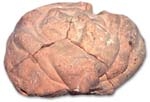- Home
- Hârsova, the chalcolithic village
- The Arts of Fire
- The potter's story
It is an astonishing transformation from the rough clay to the superb vases of the Gulmentia culture ! First it was necessary to find and gather good clay, to clean it of impurities, such as roots and gravel, and finally to knead the clay into the consistency suitable for use.
The potter then had to add a degreasing ingredient (fine sand or finely-chopped straw) necessary for successful baking of the clay, and then vary the amount of the degreaser according the function of the vase. It was then necessary to knead the degreased clay for long periods in order to obtain a homogeneous dough.
Then came the time to assemble the vase: a ball of clay could be pounded into a basket, serving as a mould, to form the base and the beginning of the body of the vase. By adding small clay wads, welded together by wetting them and smoothing the joints with the fingers, the body of the vase was gradually assembled. And the neck? Beginning with a ball of clay rolled into a band, the band rolled up in a truncated cone and welded with a barbotine technique onto the top of the body, the skillful potter succeeded in completing the vase.
After a light drying in the shade, the vase was ready for some finishing touches. Using flint and bone tools, the shape of the vase was perfected by scraping and smoothing. It was then let dry further before carefully polishing the still damp clay, a process most likely using a tool made of astragal. It then could be painted and decorated and left to dry further before baking. The firing of the vase was certainly a matter of great mastery of both furnace and fuels.
Astragal of a pig, cow or goat, have one or two abrasive faces, and serve as polishing stone or sand paper.
A cow's rib, with many traces of its use as a tool in pottery, probably used to scrape and polish the exterior of work.
Ball of clay already fired, mostly likely used to control.


